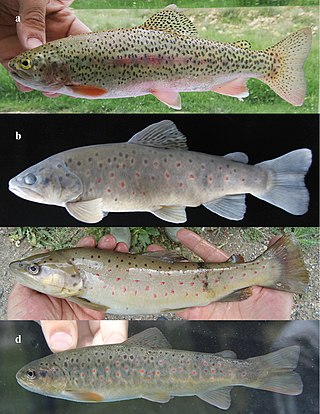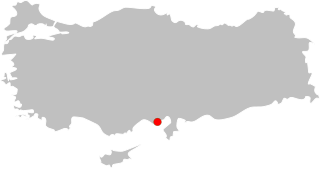
The brown trout is a species of salmonid ray-finned fish and the most widely distributed species of the genus Salmo, endemic to most of Europe, West Asia and parts of North Africa, and has been widely introduced globally as a game fish, even becoming one of the world's worst invasive species outside of its native range.

Salvelinus is a genus of salmonid fish often called char or charr; some species are called "trout". Salvelinus is a member of the subfamily Salmoninae within the family Salmonidae. The genus has a northern circumpolar distribution, and most of its members are typically cold-water fish that primarily inhabit fresh waters. Many species also migrate to the sea.
Salmo obtusirostris salonitana is an endemic trout subspecies found in the Jadro River in the vicinity of Solin, and in the nearby Žrnovnica River, where it was introduced in 1964. The upper reaches of the Jadro River including Jadro Spring, covering an area of 7.8 hectares, have been protected as an ichthyological reserve since 1984, for the purpose of preserving this endangered fish species, S. o. salonitana.

Alburnoides is a genus of cyprinid fishes native to Europe and Asia. Many species are known as riffle minnows or spirlins.

Alburnus is a genus of fish in the family Cyprinidae, the carps and minnows. They are known commonly as bleaks. A group of species in the genus is known as shemayas. The genus occurs in the western Palearctic realm, and the center of diversity is in Turkey.

Capoeta, also known as scrapers, is a genus of fish in the family Cyprinidae found in Western Asia. The distribution extends from Turkey to the Levant, to Transcaucasia, Iraq, Turkmenistan, in Armenia, particularly in lake Sevan and northern Afghanistan. This genus is most closely related to Luciobarbus and in itself is divided into three morphologically, biogeographically and genetically distinct groups or clades: the Mesopotamian clade, the Anatolian-Iranian clade and the Aralo-Caspian clade.

Chondrostoma is a genus of ray-finned fish in the family Cyprinidae. They are commonly known as nases, although this term is also used locally to denote particular species, most frequently the common nase . The common name refers to the protruding upper jaw of these fishes; it is derived from the German term Nase 'nose'.

Gobio is a genus of typical gudgeons, ray-finned fish in the family Cyprinidae many of which are endemics of south-eastern Europe. Members of the genus are usually small fish, rarely longer than 10 cm.
Squalius is a genus of fish in the family Cyprinidae found in Europe and Asia. Hybridization is not rare in the Cyprinidae, including this genus. S. alburnoides is known to be of ancient hybrid origin, with the paternal lineage deriving from a prehistoric species related to Anaecypris; the latter mated with ancestral S. pyrenaicus. Present-day S. alburnoides mates with sympatric congeners of other species.

Salmo dentex is a variety of trout, a freshwater fish in the family Salmonidae, found in the western Balkans. Until recently the identity, biological distinctness and species status of the dentex trout were not properly clarified, but genetic data now suggest it is not a monophyletic unit that could be distinguished from other salmonids as a separate species.
Salmo macrostigma is a species of freshwater trout endemic to Algeria in northwest Africa. It can reach a length of 60 centimetres (24 in) TL.

Lake Sapanca is a fresh water lake in Turkey, between the Gulf of İzmit and the Adapazarı Meadow. The lake has a catchment area of 251 km², surface area is 45 km², a length 16 km east–west / 5 km north–south, and a maximum depth of 52 m. Lake Sapanca, Turkey
Luciobarbus is a genus of ray-finned fishes in the family Cyprinidae. Its members are found in fresh and brackish waters of southern Europe, northern Africa, the wider Near East, the Aral and Caspian Seas, and rivers associated with these. Several species in the genus are threatened. Most species are fairly small to medium-sized cyprinids, but the genus also includes several members that can surpass 1 m (3.3 ft) in length and the largest, the mangar can reach 2.3 m (7.5 ft).
Paracobitis is a genus of Asian stone loaches.
Salmo opimus is a salmonid fish in the genus Salmo. It was described by Davut Turan, Maurice Kottelat and Semih Engin in 2012, and is known from Turkey. The type locality was the Alara Stream in Gündoğmuş, Antalya Province. The species epithet, "opimus" refers to the large body size of the adults.

Salmo ciscaucasicus, the Caspian salmon or Terek trout, is a salmonid fish endemic to the Caspian Sea and its inflowing rivers. It was described in 1967 originally as a subspecies of Salmo trutta. S. ciscaucasicus lives on the western shore of the lake from northern Azerbaijan to the Ural River, while the main breeding river is the Terek. It lives at depths down to 50 m. Males can reach a maximum standard length of 130 cm. Forms of the species include anadromous, lacustrine, and resident. In the northern Ural and Volga, there may be hybrids between S. ciscaucasicus and S. trutta.

Salmo chilo is a salmonid fish, a relative of trout first described as a distinct species in 2012 from the Akdere Stream, a tributary of the Ceyhan River in Turkey. It is described as having a bulbous forehead, a blunt snout, and a mouth located on the bottom of the head with fleshy lips.
Salmo coruhensis is a species of trout, a freshwater salmonid fish. It lives in streams flowing into the Black Sea, in Turkey and possibly Georgia.

Salmo kottelati is a species of trout endemic to the Alakır Stream of Antalya Province in southern Turkey. It was previously considered part of Salmo macrostigma.

The Caspian trout is a disputed species of fish in the family Salmonidae. It is native to Eurasia, where it occurs only in the southern Caspian Sea basin. It reaches 25 cm in standard length. While historically considered a distinct species, recent evidence suggests that the Caspian trout, as well as the Black Sea salmon and the Abant trout are not distinct species but are instead morphs of the brown trout.















